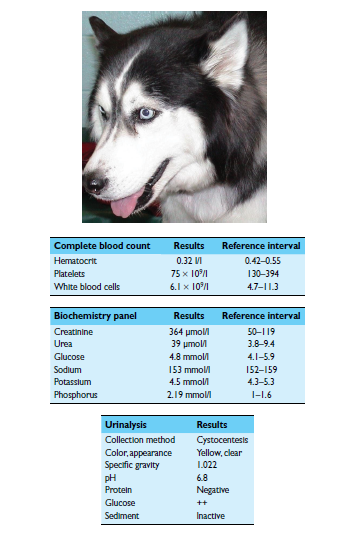Difference between revisions of "Canine Infectious Diseases: Self-Assessment Color Review, Q&A 01"
Jump to navigation
Jump to search
(No difference)
| |
Latest revision as of 09:41, 26 November 2018
| This question was provided by CRC Press. See more case-based flashcards |

|
Student tip: This case is a common clinical presentation and a good opportunity to analyse bloods. |
An 8-year-old female intact Siberian Husky from Bern, Switzerland, was evaluated for acute onset of vomiting, lethargy, and increased thirst and urination. On physical examination, the dog was estimated to be 7–8% dehydrated and had a tense abdomen on palpation. The kidneys appeared to be slightly enlarged on palpation and a large bladder was noted. The BCS was 5/9 (see image). A CBC, serum biochemistry panel, and urinalysis were performed.
| Question | Answer | Article | |
| How would you interpret the findings in this dog? | This dog has renal failure, based on the presence of increased serum urea and creatinine and the low specific gravity of the urine. Glucosuria with normoglycemia suggests renal tubular injury. The history of acute onset and the good BCS together with the slightly enlarged kidneys suggest acute kidney injury rather than chronic kidney disease. Although a low hematocrit is commonly associated with chronic kidney disease, in one study, 55% of dogs with acute kidney injury had a hematocrit below the RI. Thrombocytopenia is likely associated with the underlying disease causing the acute kidney injury. The dog’s acute kidney injury would be non-oliguric grade III according to the grading system suggested by the International Renal Interest Society (IRIS).
|
Link to Article | |
| What are the differential diagnoses for this dog? | Causes of acute kidney injury include ischemic events secondary to hypovolemia, infections (e.g. leptospirosis or pyelonephritis), renal neoplasia (especially lymphoma), and toxins (such as ethylene glycol or non-steroidal anti-inflammatory drugs). Based on the clinical findings (thrombocytopenia, azotemia, glucosuria), leptospirosis is a likely underlying cause. More than half of dogs with leptospirosis are thrombocytopenic, and glucosuria is also a common finding in this disease.
|
Link to Article | |
To To purchase the full text with your 20% discount, go to the CRC Press Veterinary website and use code VET18.
